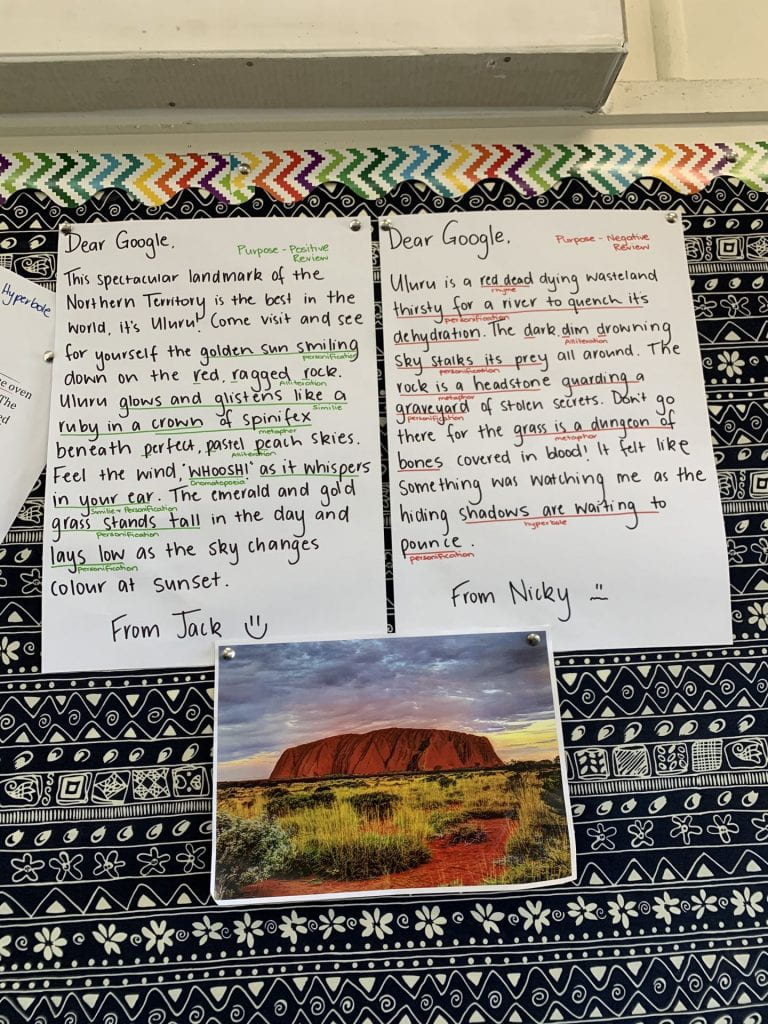2.2 Content selection and organisation
2.5 Literacy and numeracy strategies
During my professional experience at a small Catholic Primary School in rural Queensland, I taught a Years 3-6 class with eight diverse students. One of the students was diagnosed with Autism, and this combined with the multiple year levels meant I had to effectively organise content to engage the class as they varied in literacy ability from Years 1-7 (2.2, 2.5). My supervisor designed the frame for the integrated unit plan on Australian people and landscapes, and then I developed and delivered a sequence of lessons throughout placement that worked towards the summative assessment of using appropriate language features to add meaning to a written text. In knowing each learner and catering for their needs, it was critical to work closely with my teacher to offer scaffolded literacy support to the student with ASD, while also providing challenging learning goals for the other students (2.2, 2.5) (Australian Institute for Teaching and School Leadership, n.d.).
In the lessons preceding, I explicitly taught students about language features, word modality, and positive and negative words or phrases that they then practiced in their writing. The content and activities for this lesson were organised to reflect the Gradual Release of Responsibility (GRR) model, where I piqued student interest by reading my own negative review to model the standard of work I was looking for (2.2) (Churchill et al, 2019; Fellowes & Oakley). I then provided a stimulus picture of Uluru, and the class brainstormed a t-chart displaying positive and negative language features describing the image (Artefact 1). The brainstorming session provided the lower ability students with context, and a foundation with which the two mixed ability groups would then go on to use in writing their reviews in a collaborative constructivist setting (Duchesne & McMaugh, 2016). By selecting and gradually scaffolding open-ended tasks such as the written review (Artefact 2), students were able to collaboratively design their own text to demonstrate their understanding of using language features (2.2) (Fellowes & Oakley, 2014; Duchesne & McMaugh, 2016).
Upon reflection of my content selection, I could have offered more extension to the Year 6 student as she was already grasping the task quite easily (2.2). However, having to re-explain certain language features to her group further reinforced her understanding and communication of the topic (Duchesne & McMaugh, 2019; ACARA, n.d.). As a result of demonstrating APST (2.2) and (2.5) throughout this lesson, in my placement report the supervising teacher mentioned that, “Susie was exposed to the practical challenges associated with a 4-Year Multi-age class and grew in her ability to sequence her lessons and learning experiences in response to this challenge.” As a beginning teacher, I will continue to research and implement appropriate differentiation strategies to support diverse learners so that the content I select and organise is aligned to support every learner in their literacy development regardless of their ability (2.3, 2.5) (Fellowes & Oakley, 2014).


References
Australian Curriculum, Assessment and Reporting Authority (ACARA). (n.d.). Literacy. Australian Curriculum. Retrieved September 18, 2021, from https://www.australiancurriculum.edu.au/f-10-curriculum/general-capabilities/literacy/
Australian Institute for Teaching and School Leadership. (n.d). Australian professional standards for teachers. https://www.aitsl.edu.au/teach/standards
Churchill, R., Godhino, S., Johnson, N., Keddie, A., Letts, W., Lowe, K., Mackay, J., McGill, M., Moss, J., Nagel, M., Shaw, K., & Rogers, J. (2019). Teaching: Making a Difference (4th ed.). John Wiley & Sons Australia.
Duchesne, S., & McMaugh, A. (2019). Educational psychology: For learning and teaching (6th ed.). Cengage Learning Australia.
Fellowes, J., & Oakley, G. (2014). Language, literacy and early childhood education. (2nd ed.). Oxford University Press.
